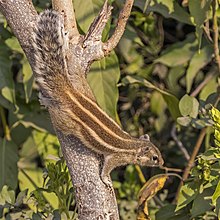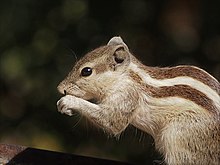| Northern palm squirrel | |
|---|---|

| |
| At Keoladeo National Park, Bharatpur, Rajasthan, India | |
| Conservation status | |
 Least Concern (IUCN 3.1) | |
| Scientific classification | |
| Domain: | Eukaryota |
| Kingdom: | Animalia |
| Phylum: | Chordata |
| Class: | Mammalia |
| Order: | Rodentia |
| Family: | Sciuridae |
| Genus: | Funambulus |
| Subgenus: | Prasadsciurus Moore & Tate, 1965 |
| Species: | F. pennantii |
| Binomial name | |
| Funambulus pennantii Wroughton, 1905 | |
| Subspecies | |
| |
| Synonyms | |
|
F. pennanti | |

The northern palm squirrel (Funambulus pennantii), also called the five-striped palm squirrel, is a species of rodent in the family Sciuridae. Some authorities recognize two subspecies, F. p. pennantii and F. p. argentescens. It is a semi-arboreal species found in tropical and subtropical dry deciduous forests and many other rural and urban habitats. It is a common species with a wide range and the International Union for Conservation of Nature has rated its conservation status as being of "least concern".
Distribution
It is found in the Andaman Islands, Nicobar Islands (where it was introduced), India, Nepal, Bangladesh, Pakistan and Iran. In India, it is fairly common in urban areas, even in large cities such as Delhi and Kolkata. Two subspecies, Funambulus pennantii argentescens and Funambulus pennantii lutescens, were suggested by Wroughton in addition to the nominate race; however, more recent workers do not make this distinction.
Thorington and Hoffman in Wilson and Reeder (2005) listed only two subspecies: F. p. pennantii and F. p. argentescens. However, Ghose, et al. (2004), described two additional subspecies: F. p. chhattisgarhi (distribution: eastern part of Maharashtra, Madhya Pradesh, Orissa, West Bengal, and Bihar) and F. p. gangutrianus (distribution: West Bengal, Madhya Pradesh, Uttar Pradesh, and Nepal), but Talmale (2007) treated the Maharashtra populations as F. p. pennantii only due to the overlapping in measurements and color variations observed in the specimens.

It has also been introduced to Australia where it is found in a very limited area and the United Arab Emirates due to the exotic pet trade. In Perth, Western Australia, there is an established population resulting from zoo escapees, and a population recorded around Mosman, New South Wales and near Taronga Zoo that may have become extinct. The feral populace, known locally as the five-lined palm squirrel, ranges out to the suburbs surrounding the Perth Zoo and also inhabits the grounds. They give birth over a period from August to May and most intensively around the austral spring and autumn.
In India, the southern boundary of the species' range is not clearly identified, and recent records suggest it may extend as far as Madanapalli. The southern boundary on the Western Ghats side clearly extends to localities including Dharwar and Mysore, in Karnataka.
Habitat

The northern palm squirrel is a very adaptable species. It occurs in tropical and subtropical dry deciduous forest, montane forests to altitudes of 4,000 m (13,123 ft), scrublands, plantations, grasslands, arable land, rural gardens and urban areas.
Status
The northern palm squirrel is a common species throughout most of its wide range. It is an adaptable species and no particular threats have been identified, and the International Union for Conservation of Nature has rated its conservation status as being of "least concern".
Disease
These squirrels do not naturally suffer from foot and mouth disease. Tewari et al. 1976 did experimentally infect them and the resulting disease was severe. However no transmission could be induced.
References
- ^ Nameer, P.O.; Molur, S. (2017) . "Funambulus pennantii". IUCN Red List of Threatened Species. 2016: e.T8702A115088099. doi:10.2305/IUCN.UK.2016-3.RLTS.T8702A22259750.en. Retrieved 23 November 2021.
- Wroughton, R.C. (1905). "The common striped palm squirrel". Journal of the Bombay Natural History Society. 16: 406–413.
- Moore, J.C.; Tate, G.H.H. (1965). "A study of the diurnal squirrels, Sciurinae, of the Indian and Indo-Chinese subregions". Fieldiana Zoology. 48: 1–351. doi:10.5962/bhl.title.2919.
- ^ Thorington, R.W. Jr.; Hoffmann, R.S. (2005). "Family Sciuridae". In Wilson, D.E.; Reeder, D.M (eds.). Mammal Species of the World: a taxonomic and geographic reference (3rd ed.). The Johns Hopkins University Press. pp. 754–818. ISBN 0-8018-8221-4. OCLC 26158608.
- Thorington, R. W. Jr; R. S. Hoffman (2005). "Family Sciuridae". In Wilson, D. E.; Reeder, D. M. (eds.). Mammal Species of the World a Taxonomic and Geographic Reference. Johns Hopkins University Press, Baltimore. pp. 754–818.
- Ghose, R. K.; Mandal, Ajoy Kumar; Ghose, Partha Sarathi (2004). "A contribution to the taxonomy of Indian fivestriped squirrel (Funambulus pennanti Wroughton), with description of two new subspecies [sic pennanti]" (PDF). Records of the Zoological Survey of India. 102 (3–4): 89–103. doi:10.26515/rzsi/v102/i3-4/2004/159511.
- Talmale, S.S. (2007). Studies on Small Mammal Diversity in Maharashtra State. Ph. D. Thesis submitted to University of Pune, Maharashtra State, India.
- Ellerman, J.R. (1961). The fauna of India including Pakistan, Burma, and Ceylon: Mammalia, Rodentia. Zoological Survey of India, Calcutta.
- Srinivasulu C.; S. Chakraborty; M.S. Pradhan (2004). "Checklist of the Sciurids (Mammalia: Rodentia: Sciuridae)". Zoos' Print Journal. 19 (2): 1351–1360. doi:10.11609/jott.zpj.19.2.1351-60.
- Fleming, Patricia A.; Bateman, Philip W. (2016-03-06). "The good, the bad, and the ugly: which Australian terrestrial mammal species attract most research?". Mammal Review. 46 (4). Mammal Society (Wiley): 241–254. doi:10.1111/mam.12066. ISSN 0305-1838.
- Long, J. L. (2003). Introduced Mammals of the World: Their History, Distribution, and Influence. Csiro Publishing, Collingwood, Australia. ISBN 9780643099166
- Menkhorst, P.W.; Knight, F. (2011). A field guide to the mammals of Australia (3rd ed.). Melbourne: Oxford University Press. p. 210. ISBN 9780195573954.
- Pradhan, M.S. and Kurup, G.U. (2001). Mammalia IN Fauna of Nilgiri Biosphere Reserve. Fauna of conservation Area Series 11. Publ: Director, Zoological Survey of India, Kolkata: 311–330.
- Santharam, V. (2007). "Five-striped Palm Squirrel (Funambulus pennantii) in Rishi Valley, Chittoor district, Andhra Pradesh". Journal of the Bombay Natural History Society. 104 (2): 202–203.
- ^ Weaver, Genevieve V.; Domenech, Joseph; Thiermann, Alex R.; Karesh, William B. (2013-10-01). "Food And Mouth Disease: A Look From The Wild Side". Journal of Wildlife Diseases. 49 (4). Wildlife Disease Association (Allen Press): 759–785. doi:10.7589/2012-11-276. ISSN 0090-3558. PMID 24502706.